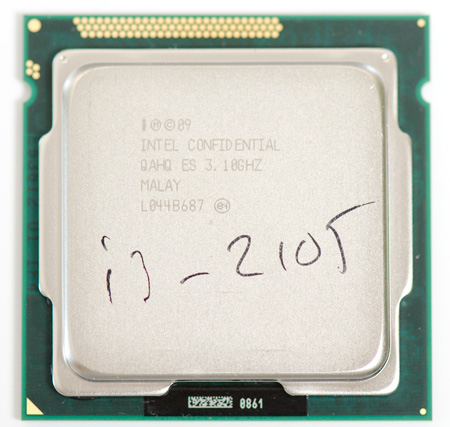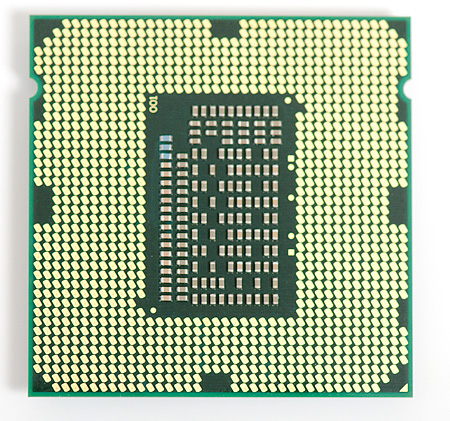The AMD A8-3850 Review: Llano on the Desktop
by Anand Lal Shimpi on June 30, 2011 3:11 AM ESTThe Direct Competitor: Intel's Core i3-2105
When Intel launched Sandy Bridge the only way you could get the faster integrated graphics option (Intel HD 3000) on the desktop was to buy one of the more expensive K-series chips. The logic didn't make a ton of sense given that lower priced systems are usually the ones that depend on integrated graphics. In the weeks before Llano's arrival however, we met a new member of the Sandy Bridge family - the Core i3-2105:

The 2105 is virtually identical to the 2100 it augments. It's still a dual-core processor (HT enabled) with a 3MB L3 cache . There's no turbo boost and you still get all of the same checkbox features (e.g. Quick Sync, VT-x, no VT-d, no AES-NI, etc...). There are only two differences between these two parts. The i3-2105 has an Intel HD Graphics 3000 core vs 2000 in the 2100, and the 2105 is priced at $134 (one dollar cheaper than the A8-3850).

It's clear that this HD 3000 equipped Core i3-2105 is intended to compete directly with the A8-3850.
The Test
The CPU tests in this review use an identical configuration to everything else in Bench (4GB memory, Intel X25-M SSD, discrete GPU etc...). The table below is for the processor graphics comparisons. All Intel HD 3000 numbers were generated using the Core i3-2105.
All discrete GPUs use our standard GPU testbed (3.33GHz Nehalem). This does prevent our usual efforts to keep our testbeds identical, however with low-end GPUs the contamination should be minimal as we’re GPU bound and then some, rather than being CPU bound.
| CPU: | AMD A8-3850 Intel Core i3-2105 |
| Motherboard: | ASUS P8Z68V-Pro (Intel Z68) ASRock A75 Extreme6 (AMD A75) |
| Chipset Drivers: | Intel 9.2.0.1025 AMD Catalyst 8.862 RC1 |
| Hard Disk: | Corsair P256 SSD (256GB) |
| Memory: | G.Skill DDR3-1866 2 x 4GB |
| Video Drivers: | AMD Catalyst 8.862 RC1 Intel 2372 |
| Desktop Resolution: | 1920 x 1200 |
| OS: | Windows 7 x64 |










99 Comments
View All Comments
Roland00Address - Thursday, June 30, 2011 - link
1366x768 would be preferable than 1024x768, for very few things use 1024x768 anymore, and 1366x768 is the default resolution for 720p tvs, 18.5 inch monitors, and older cheap monitors bought in the last 3 to 4 years.BigDDesign - Friday, July 1, 2011 - link
I like to play games. 1024X768 is useable in a pinch. So bragging is out. Who cares?CSMR - Sunday, July 3, 2011 - link
What do you mean, image quality comparison? If two graphics cards differ in image quality, one of them does not work and needs bug-fixes. So your question is really, are there any bugs in graphics output on this "APU".Unfortunately sites often do "image quality comparisons" but it is nonsense, actually marketing nonsense.
Musafir_86 - Tuesday, July 5, 2011 - link
-Image Quality (IQ) here means the rendered 3D images of 3D games, the latest of them includes Crysis 2, DiRT 3, etc.-In most games, different levels of quality (quality setting like low, medium, high) is provided for scalability reason (so they can cater a wider range of customers).
-Different GPU uses different algorithms/techniques or 'tweaks' to squeeze maximum performance at a given quality metric. So, in applying those tweaks, the rendered output is sometimes different between one another even though the quality level is same (e.g. High vs. High). Driver maturity is also another contributing factor.
-FYI, Anandtech DOES provide IQ comparisons before, especially when comparing new Radeon and GeForce generations.
-BTW, I hope the IQ comparison as promised by Ganesh would be available soon.
Regards.
ckryan - Thursday, June 30, 2011 - link
Like the mobile version, Llano on the desktop is actually kinda impressive. Not necessarily for its current perfomance, but rather as an indication of what to expect from Trinity. With a significant performance boost to both parts of the CPU, I can easily envision my next laptop using Llano's successor.While its impossible not to compare these parts to Sandy Bridge, its not like a Phenom II x4 is hopelessly obsolete. Llano's desktop power figures are pretty good, but it seems like the 2105 draws way more power than it needs at idle -- my i5 2500k/P67 and a GTX 460 pulls 49w from the wall according to my P3 Kill A Watt.
Still, I'm glad to see AMDs fusion initiative paying some dividends. It's good to have options, but I think it's time they stopped playing hard to get with Bulldozer.
L. - Thursday, June 30, 2011 - link
Hey .. I was just thinking, considering the scaling, would you just run those tests again with a decent memory kit ?I mean, most people buying Llano will probably get 1866 at the price of 1600, considering usual RAM market trends (1333 is dead/ price rising - 1600 is bottom price, many kits actually do much more than their SPD - 1866 is bottom within 3 months I guess, etc.).
So, what about some real neat kits @ 2.2+ or even relatively cheap ones around 2Ghz ?
I'm pretty sure that's where Llano will start making sense (or ... with quad-ddr5 .. 8 times the bandwidth should do the trick, right ?)
L. - Thursday, June 30, 2011 - link
I forgot one detail, there is no benchmark showing how that 6550D fares when you add a bit of shiny to your gfx settings, is it really so pitiful noone would ever consider pressing the button ?mino - Sunday, July 3, 2011 - link
i* cannot handle that, so writing such is a big no-no.jjj - Thursday, June 30, 2011 - link
No overclocking section :(I know the ASRock A75 Extreme6 review covers it a bit,but not nearly enough(doesn't even tell us idle voltages)
Was curious to see how it overclocks in a few scenarios:
- with a discrete GPU (IGP fully sleeping)
- with 2 CPU cores disabled (if it is even possible)
- with the GPU starved by limiting the ammount of ram it gets
- how far can it be underclocked
beginner99 - Thursday, June 30, 2011 - link
Marketed for years as being something special (APU) but seriously it's nothing special at all. Intel was 1.5 years earlier (Arrandale). Agreed the power of the igp was pretty bad but still...This is basically only usable in the mobile version. And there it ain't to bad especially in terms of power consumption. Considering AMDs mobile track record in the last couple of year I would say its a pretty good comeback. And this was obviously its main target.